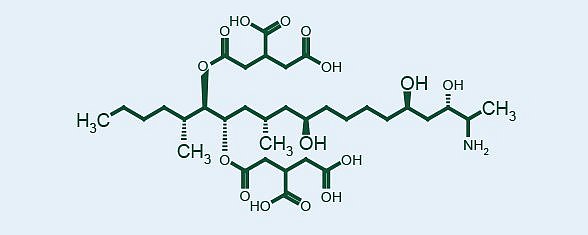What is Fumonisin?

Fumonisins are a group of toxins, primarily, FB1, FB2, FB3. They are not fluorescent and were discovered in 1988, in South Africa Gelderblom et al., 1988; Marasas, 2001)
Production and occurrence
There are two major producers, Fusarium verticillioides and Fusarium proliferatum, however other closely related species are capable of producing these toxins but are less important in grains. All strains are considerably variable in toxin producing ability.
Corn is the major commodity affected by this group of toxins, although a few occurrences have been reported in rice and sorghum. Fumonisins have been reported in barley but this awaits confirmation in further samples. The exact conditions for disease are not known but drought stress followed by warm, wet weather during flowering seems to be important.
Insect damage to maturing corn ears allows for environmentally present strains of the organism to enter the ear and kernels. Wet weather just prior to harvest may exacerbate the contamination with fumonisins in corn. However, the organism is present in virtually every seed and is present in the corn plant throughout its growth and therefore is present in the ears and kernels. Sometimes there is considerable amount of fumonisins present in symptomless kernels of corn.
As mentioned, some corn kernels may have no evidence of infection as the organism is internal and capable of toxin production. Other corn may demonstrate “pink kernel rot” with a closely adhering organism on the kernels. Sometimes the kernels will be covered with white fungal growth instead of pink. Those kernels with insect or bird damage or broken kernels will often contain the highest levels of toxin. Thus, corn screenings will contain the highest levels of toxins and are often found to be the cause of animal toxicoses. In rice, fumonisins have been found to be present where sheath rot disease is present.
Grains should be harvested without kernel damage, screened and dried to a level of moisture suitable for storage (<14%). Conditions favorable to mold growth likely will cause the further formation of fumonisins in storage. Grains should be kept free of additional moisture or insects. At this time, not much information is available for storage of fumonisin contaminated corn, but cleaning can considerably reduce the concentration levels in corn.
Toxicity
A major disease of horses that includes a softening of the white matter in the brains (leukoencephalomalacia) is caused by the fumonisins (Marasas et al., 1988). Swine lung edema is also produced by the fumonisins (Harrison et al., 1990; Ross et al., 1990). Other diseases such as liver disease and tumors have been noted in rodents (Voss et al., 2001). The fumonisins are tumor promoters and one study demonstrated total carcinogenesis, which has been confirmed in a two year study by the FDA. It is not known whether the fumonisins are truly involved in causing esophageal tumors in certain human populations. Fumonisins remain as suspect entities in neural tube defects in humans in certain regions of the world and is a current area of investigation (Marasas et al., 2004). Regardless of the other effects on animals, the liver is often involved in the toxicity. There is no carryover of fumonisins into milk in cattle and there appears to be little absorption of toxin in tissues but what little is rapidly taken up is rapidly eliminated.
Published on:
Mycotoxin